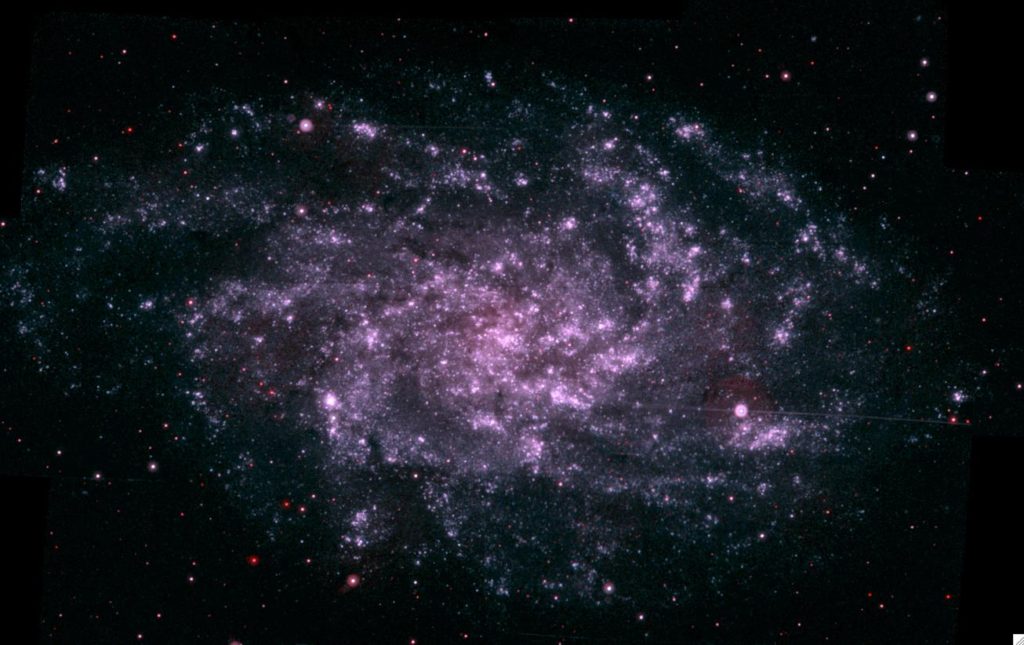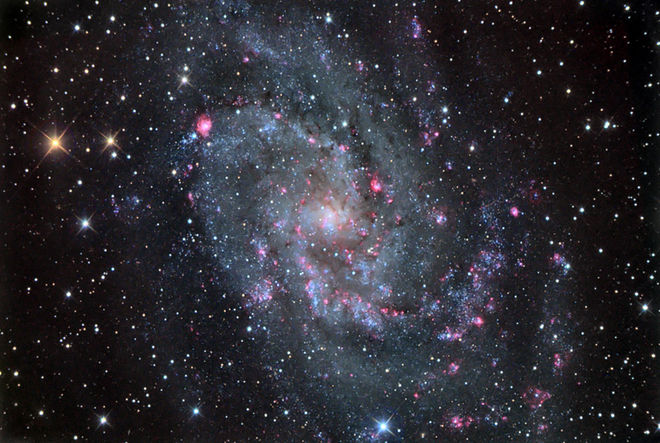
Some galaxies, like the Milky Way, have a distinct bar shape at the core, but Triangulum does not. Instead, the Triangulum galaxy has bright star forming areas. A small cluster within the Triangulum galaxy, called NGC 604, is the largest stellar “nursery” within the Milky Way, Andromeda Galaxy and Triangulum Galaxy. NGC 604 and other variables with the Triangulum Galaxy are popular places to image because they are close, less than 3 million light years away.
When the NASA’s Swift satellite first stared taking pictures in 2007-2008, it focused on the Triangulum Galaxy. At the time, it created the “most detailed ultraviolet image of an entire galaxy ever taken.” The bright purples and blues highlight the star formation happening in the Triangulum Galaxy.
Triangulum Galaxy Profile
Designation: Messier 33 or NGC 598
Type: Spiral Galaxy
Diameter: 50,000 light-years
Distance from Earth: < 3,000,000 light-years
Mass: 50,000,000 times the mass of the Sun
Location: Triangulum Constellation
When it was discovered: 1764 (officially)
Estimated Number of Stars: 40,000,000,000 ( 40 billion )
Facts about the Triangulum Galaxy:
• It is often mistakenly called the Pinwheel Galaxy, but the official “Pinwheel Galaxy” is actually Messier 101.
• It is likely that the Triangulum Galaxy interacted with the nearby, larger Andromeda Galaxy in the past.
• There are several streams of neutral hydrogen and stars linking the two galaxies, which is why scientists think they may have interacted in the past.
•The Andromeda Galaxy and Milky Way are both larger than the Triangulum Galaxy.
•The Triangulum Galaxy may be an example of an “inside-out” galaxy formation. In this process, gas is exhausted at the galaxy’s inner core and is accumulated toward the outer edges of the galaxy. This results in an inner core and outer halo with different compositions. Scientists have observed these two distinct areas in the Triangulum Galaxy.
• An Arizona photographer Chris Schur made headlines in 2016 when he released a stunning image of the Triangulum Galaxy. This is the photo he took.

• Near the Triangulum Galaxy, there is an area that looks like three bubbles inside of each other. Scientists believe that this strange shape is the result of three different supernovae. The first supernova expanded as it exploded and formed the outer shell. Then two more smaller and quicker supernovae within created the other two smaller shells.
• Scientists have calculated that the star formation within the Triangulum Galaxy probably occurs at the rate of about half the mass of the sun per year.
• The largest stellar mass black hole ever discovered was found within the Triangulum Galaxy in 2007. The black hole, named M33 X-7, is estimated to be 15 times the mass of the sun.
• The apparent magnitude, which measures the brightness of an object as seen by a person on Earth, of the Triangulum Galaxy is 5.72. In this scale, smaller numbers are brighter, with the brightest object being the sun at -27. Objects visible to the naked eye usually have an apparent magnitude of less than 6.5. The Triangulum Galaxy should be visible to the naked eye, but it is often difficult to spot.
• The designation Messier 33 means that the Triangulum Galaxy was cataloged by French astronomer Charles Messier. It was the object number 33. His catalog is often considered the “discovery” of an object. However, the observations of an earlier Italian astronomer named Hodierna also match what the Triangulum Galaxy looks like, so it’s likely that Hodierna cataloged the galaxy first, nearly 100 years earlier.